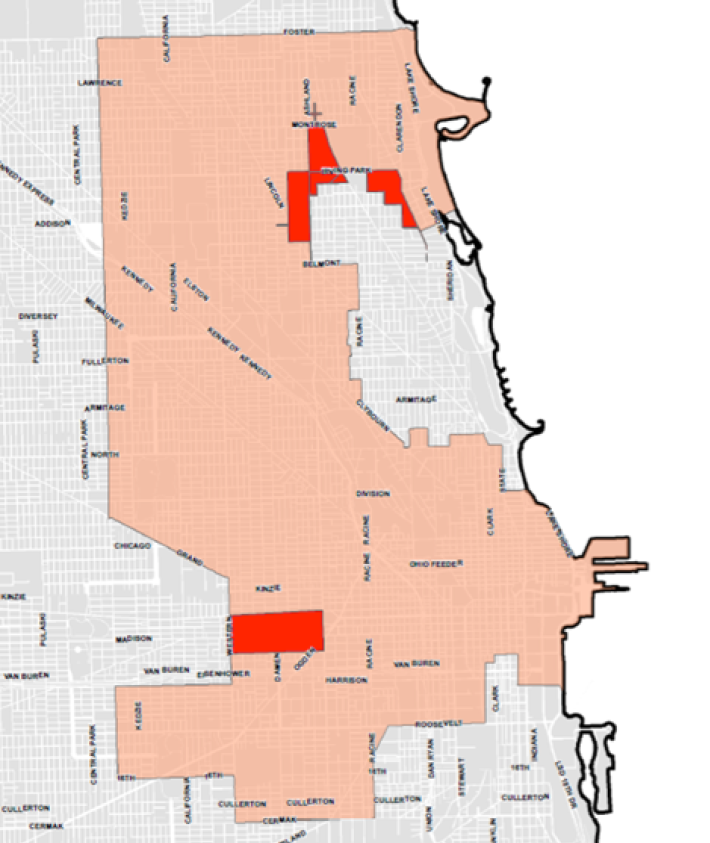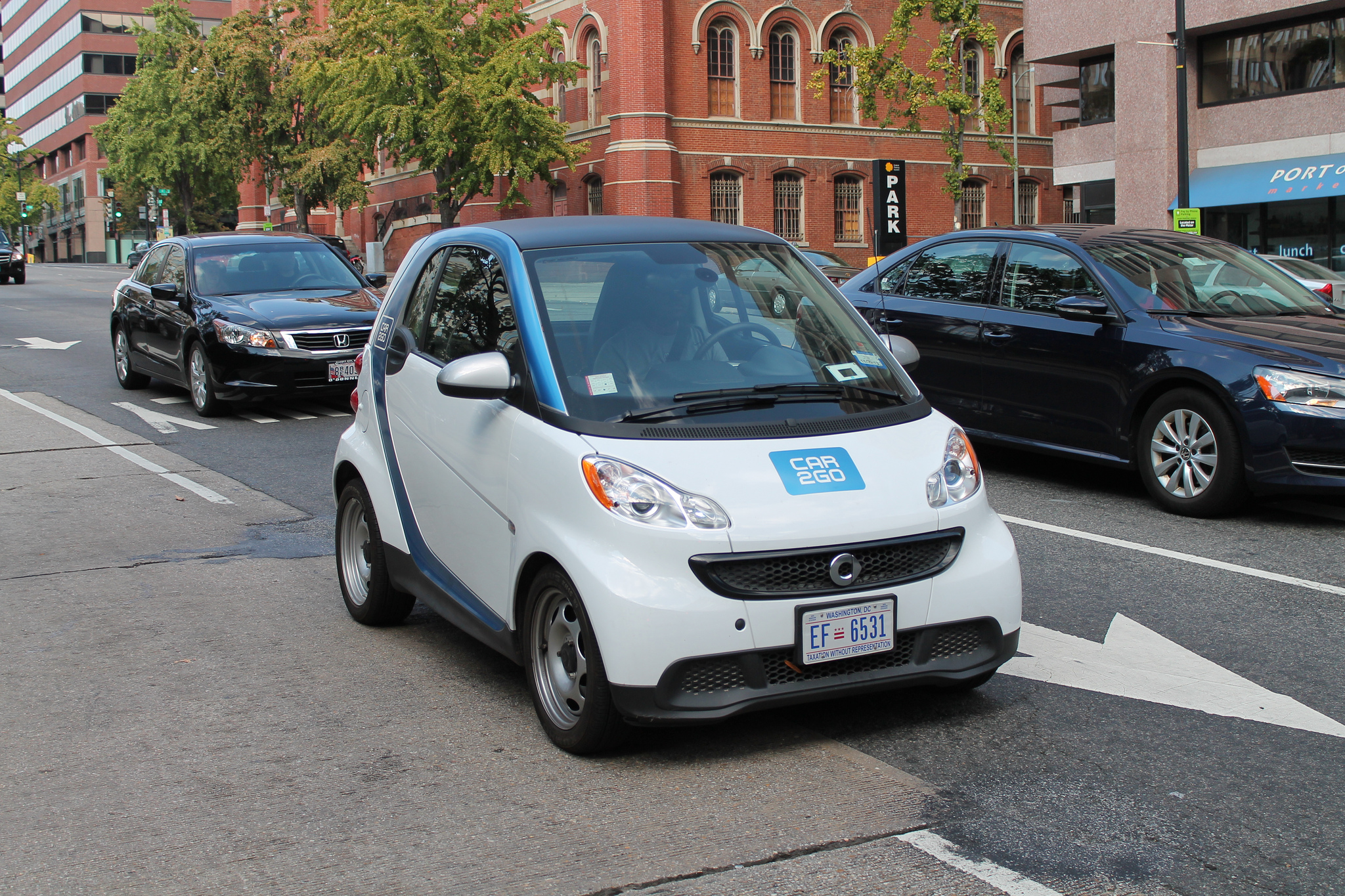This afternoon Chicago’s City Council gave its final approval to a plan to test point-to-point car-sharing, which will give residents a new option for getting around the city without using a private car. However, due to opposition from local aldermen, Lakeview and Lincoln Park won’t be taking part in the pilot. And while the ordinance originally called for the coverage area to include much of the area bounded by Foster, Kedzie, Lake Michigan and 63rd, the final coverage map doesn’t go south of Cermak.
Unlike traditional car-sharing services such as Zipcar, point-to-point, or free-floating, car-share doesn’t require users to return the vehicles to a designated spot on private property, but allows customers to park the cars for free at any legal metered or unmetered on-street space. (The company pays a fee to the city for this privilege, and due to Chicago’s hated parking contracted, our point-to-point service, Austin, Texas-based Car2go, will also have to reimburse the parking concessionaire for lost meter revenue.) This flexibility makes free-floating car-share useful for trips that don’t work well with traditional car-share, such as hauling gear to a music gig or traveling the first or last mile to or from a transit station.
Ride-hailing services like Uber and Lyft work fine for those kind of trips, but recent studies show that they've increased traffic congestion and cannibalized transit use in cities. In contrast, a 2016 UC Berkeley study of some 10,000 Car2go members found that each shared car took up to 11 private vehicles off the road, adding up to a whopping 28,000 fewer cars.
Those numbers didn’t prevent a backlash to the Chicago ordinance, proposed by Near Northwest Side alderman Joe Moreno, from colleagues like Lakeview alderman Tom Tunney and Lincoln Park alderman Michele Smith, who insisted that Car2go would make parking more difficult for their constituents who own cars. As a result, an earlier version of the proposed service area map left out their wards, but included the area bounded by Foster, 63rd Street, and the lake, with a western border of Central Park Avenue, Western Avenue, or Halsted Street, depending on the neighborhood. Tunney and Smith provided the sole votes against the ordinance when it passed City Council’s traffic safety committee last week.
Under the ordinance that passed today, Car2Go will distribute roughly 10 rental cars per square mile across the service area, called the “Home Area.” Customers pay a lifetime membership fee of about $5 to be able to rent the vehicles on the street by app. Cars can be taken out of the Home Area, but must be returned and parked in a legal, on-street parking spot to end the rental.

Therefore, a member could pick up a car parked within the service area in North Lawndale and use it to run an errand in Lincoln Park (where, unlike within the Home Zone, it would be necessary to pay to use any metered spots.) However, it would be necessary to return to the service area to park the car and end the rental. Car2go will “rebalance” the vehicles to prevent clustering, similar to how cycles are regularly redistributed within the Divvy system.
The pilot that passed City Council will last for eight months, concluding by December 2018, with a maximum of 500 cars within the service area. Car2go is know for its two-seater Smart cars, but the pilot may also include Mercedes sedans and SUVs. The vendor will be required to share data with aldermen and the Chicago Department of Transportation so that impacts on parking, congestion, and air quality can be measured. Car2go must also survey members to see if any are likely to reduce their car ownership due to the service. After the scheduled conclusion of the test, the Council can vote to end it for good, or allow the pilot to be extended as late as June 30, 2019.
The pilot will create a permit to allow free-floating cars access to residential permit parking zones within the Home Area for $75 per vehicle. Special parking restrictions will apply around Wrigley Field and the United Center during games and concerts.
Car2go eastern regional director Josh Moskowitz hailed the passage of the ordinance in a statement this afternoon. “Chicago is an incredible city ideally suited for flexible one-way car-sharing, and we are thrilled that the city has voted to establish a car-share pilot program. Over one million people across North America already use car2go, and with the passage of this pilot project, car2go intends to bring our service to Chicagoans this year.”
Spokespersons for CDOT and Alderman Moreno did not immediately respond to questions about why the approved coverage area stops at Cermak instead of going south to 63rd, as originally proposed. Car2go spokesman Tim Frisbie (formerly of the Chicago-based Shared-Use Mobility Center responded, “Due to current parking complexities around Comiskey Park, Wintrust Arena, and the Obama Presidential Library, the city thought it was best to exclude these areas during the pilot period.”
While it’s great that Chicago is moving forward with the pilot, it’s a shame that the major swath of the South Side that was originally proposed to be part of the Home Zone won’t be included. Car ownership rates are relatively low in many of those communities, so it’s unfortunate that the residents won’t have a chance to try out this new transportation option near their homes. But hopefully the program will prove successful, so that aldermen from all over the city will become interested in bringing the service to their wards.
Update 3/29/18, 8:00 AM: CDOT spokesman Mike Claffey provided the following explanation for why some South Side neighborhoods were ultimately deleted from the Home Zone. "There were a number of complicating factors in extending the boundary as far south as initially considered. If the pilot is a success, we expect that the City Council will consider extending the program further south and to other areas not included in the pilot. For the pilot program to work, we thought it made sense for the service area to be as contiguous and as simple as possible."
Update 3/29/18, 11:00 AM: First Ward staffer Jerry Mandujano confirmed Car2go's and CDOT's explanations for why the South Side was largely excluded from the final coverage area. "Alderman Moreno is excited to get this pilot off the ground and he hopes the program will do what's expected, ease congestion," Mandujano said. He added that the data-sharing requirement and other checks and balances in the ordinance will allow the city to keep tabs on the initiative and ensure that it's doing more good than harm. "If this goes well, hopefully a lot of Chicago can be included, not just focusing on the North Side but also the South Side and West Side as well."




